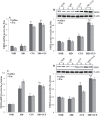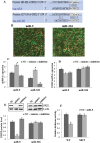Dopamine Receptor D2 and Associated microRNAs Are Involved in Stress Susceptibility and Resistance to Escitalopram Treatment
- PMID: 25740916
- PMCID: PMC4571637
- DOI: 10.1093/ijnp/pyv025
Dopamine Receptor D2 and Associated microRNAs Are Involved in Stress Susceptibility and Resistance to Escitalopram Treatment
Abstract
Background: Early life stress has been demonstrated to increase the risk of developing depression in adulthood. However, the roles and associated molecular mechanisms of stresses in the onset and relapse of depression have yet to be fully elucidated.
Methods: Depression-like behaviors were induced in rats by maternal deprivation and chronic unpredictable stress. Depression- and anxiety-like behaviors of rats, dopamine receptor D2 level, and microRNAs expression in rats' brain tissues were measured.
Results: Chronic unpredictable stress alone induced depression-like behaviors in rats, but maternal deprivation enhanced the effect of chronic unpredictable stress. Escitalopram significantly decreased depression-like behaviors in chronic unpredictable stress rats but was less effective in maternal deprivation with chronic unpredictable stress rats. Maternal deprivation increased dopamine receptor D2 messenger RNA expression and decreased microRNA-9 expression in the striatum. Chronic unpredictable stress increased dopamine receptor D2 mRNA and protein levels and decreased microRNA-9 expression in the nucleus accumbens. Furthermore, maternal deprivation enhanced the effect of chronic unpredictable stress on dopamine receptor D2 gene and microRNA-9 expression. Chronic unpredictable stress increased the expression of microRNA-326 in the nucleus accumbens but decreased it in the striatum, whereas maternal deprivation elevated microRNA-326 expression in the striatum. Escitalopram normalized microRNA-326 expression but had no effect on the expression of microRNA-9, dopamine receptor D2 mRNA, and dopamine receptor D2 protein in both the nucleus accumbens and striatum. The in vitro study showed that only microRNA-9 directly targeted the 3' untranslated region of dopamine receptor D2 mRNA and inhibited dopamine receptor D2 protein expression.
Conclusion: Early life stress enhanced the susceptibility to late life stress and resistance to escitalopram treatment through decreasing microRNA-9 expression and subsequently upregulating dopamine receptor D2 expression in the nucleus accumbens. microRNA-326 may be a novel target of escitalopram.
Keywords: depression; dopamine receptor D2; microRNAs; stress.
© The Author 2015. Published by Oxford University Press on behalf of CINP.
Figures




Similar articles
-
Maternal deprivation enhances behavioral vulnerability to stress associated with miR-504 expression in nucleus accumbens of rats.PLoS One. 2013 Jul 26;8(7):e69934. doi: 10.1371/journal.pone.0069934. Print 2013. PLoS One. 2013. PMID: 23922862 Free PMC article.
-
Maternal deprivation-caused behavioral abnormalities in adult rats relate to a non-methylation-regulated D2 receptor levels in the nucleus accumbens.Behav Brain Res. 2010 Jun 19;209(2):281-8. doi: 10.1016/j.bbr.2010.02.005. Epub 2010 Feb 6. Behav Brain Res. 2010. PMID: 20144661
-
Suppression of reward-induced dopamine release in the nucleus accumbens in animal models of depression: Differential responses to drug treatment.Neurosci Lett. 2017 May 22;650:72-76. doi: 10.1016/j.neulet.2017.04.028. Epub 2017 Apr 19. Neurosci Lett. 2017. PMID: 28432029
-
Dendritic Spines in Depression: What We Learned from Animal Models.Neural Plast. 2016;2016:8056370. doi: 10.1155/2016/8056370. Epub 2016 Jan 10. Neural Plast. 2016. PMID: 26881133 Free PMC article. Review.
-
Chronic mild stress-induced anhedonia: a realistic animal model of depression.Neurosci Biobehav Rev. 1992 Winter;16(4):525-34. doi: 10.1016/s0149-7634(05)80194-0. Neurosci Biobehav Rev. 1992. PMID: 1480349 Review.
Cited by
-
Epigenetics: A Missing Link Between Early Life Stress and Depression.Adv Exp Med Biol. 2021;1305:117-128. doi: 10.1007/978-981-33-6044-0_8. Adv Exp Med Biol. 2021. PMID: 33834398 Review.
-
Early Life Stress and the Onset of Obesity: Proof of MicroRNAs' Involvement Through Modulation of Serotonin and Dopamine Systems' Homeostasis.Front Physiol. 2020 Jul 28;11:925. doi: 10.3389/fphys.2020.00925. eCollection 2020. Front Physiol. 2020. PMID: 32848865 Free PMC article. Review.
-
Oral Delivery of miR-320-3p with Lipidic Aminoglycoside Derivatives at Mid-Lactation Alters miR-320-3p Endogenous Levels in the Gut and Brain of Adult Rats According to Early or Regular Weaning.Int J Mol Sci. 2022 Dec 22;24(1):191. doi: 10.3390/ijms24010191. Int J Mol Sci. 2022. PMID: 36613633 Free PMC article.
-
The Importance of Epigenetics in Diagnostics and Treatment of Major Depressive Disorder.J Pers Med. 2021 Mar 1;11(3):167. doi: 10.3390/jpm11030167. J Pers Med. 2021. PMID: 33804455 Free PMC article. Review.
-
miRNA regulation of social and anxiety-related behaviour.Cell Mol Life Sci. 2020 Nov;77(21):4347-4364. doi: 10.1007/s00018-020-03542-7. Epub 2020 May 14. Cell Mol Life Sci. 2020. PMID: 32409861 Free PMC article. Review.
References
-
- Basso AM, Gallagher KB, Bratcher NA, Brioni JD, Moreland RB, Hsieh GC, Rueter LE. (2005) Antidepressant-like effect of D2/3 receptor-, but not D4 receptor-activation in the rat forced swim test. Neuropsychopharmacol 30:1257–1268. - PubMed
-
- Baudry A, Mouillet–Richard S, Schneider B, Launay JM, Kellermann O. (2010) miR-16 targets the serotonin transporter: a new facet for adaptive responses to antidepressants. Science 329:1537–1541. - PubMed
-
- Cabib S, Puglisi-Allegra S. (2012) The mesoaccumbens dopamine in coping with stress. Neurosci Biobehav Rev 36:79–89. - PubMed
-
- Dunlop BW, Nemeroff CB. (2007) The role of dopamine in the pathophysiology of depression. Arch Gen Psychiatry 64:327–337. - PubMed
Publication types
MeSH terms
Substances
LinkOut - more resources
Full Text Sources
Other Literature Sources

